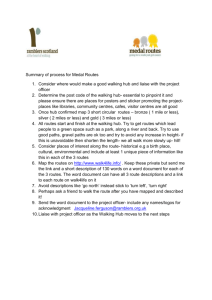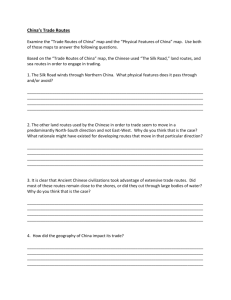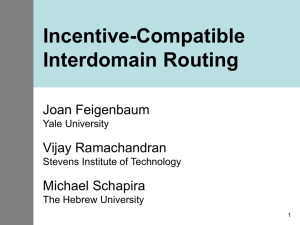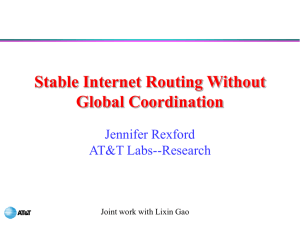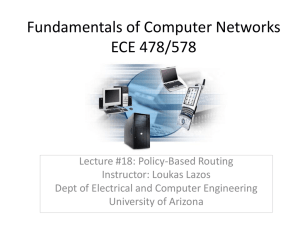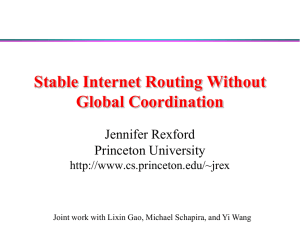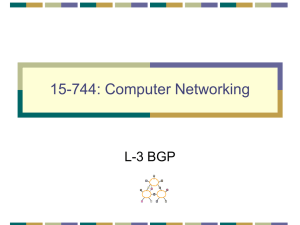The TCS-Research Community's View of the TONC Initiative
advertisement
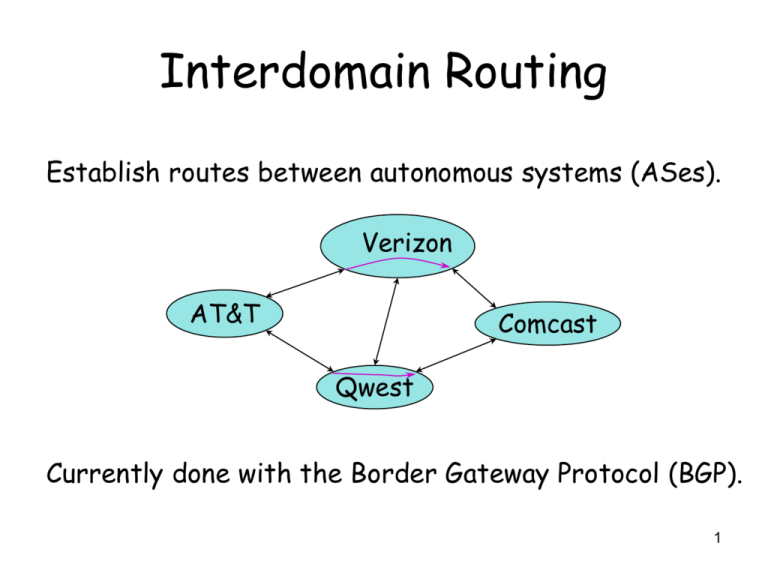
Interdomain Routing Establish routes between autonomous systems (ASes). Verizon AT&T Comcast Qwest Currently done with the Border Gateway Protocol (BGP). 1 Why is Interdomain Routing Hard? • Route choices are based on local policies. • Autonomy: Policies are uncoordinated. • Expressiveness: Policies are complex. Load-balance my outgoing traffic. Verizon AT&T Always choose shortest paths. Comcast Qwest My link to UUNET is for backup purposes only. Avoid routes through AT&T if at all possible. 2 BGP Route Processing (1) • The computation of a single node repeats the following: Receive routes from neighbors Update Routing Table Choose “Best” Route Send updates to neighbors • Paths go through neighbors’ choices, which enforces consistency. • Decisions are made locally, which preserves autonomy. • Uncoordinated policies can induce protocol oscillations. (Much recent work addresses BGP convergence.) • Recently, private information, optimization, and incentive-compatibility have also been studied. 3 BGP Route Processing (2) IP Forwarding Table Install forwarding entries for best routes Apply Import Policies Receive BGP updates Apply Policy = filter routes & tweak attributes Routing Table Storage of routes Best Route Selection Apply Export Policies Based on attribute values Apply Policy = filter routes & tweak attributes Transmit BGP updates Open-ended programming: constrained only by vendor configuration language 4 Example: Convergence Prefer direct route to d 2 1 Prefer routes through 2 d 5 Example: Oscillation Prefer routes through 1 2 1 Prefer routes through 2 BGP might oscillate forever between 1d, 2d and 12d, 21d d 6 Example: Convergence Prefer routes through 1 2 1 Prefer routes through 2 d 7 Dispute Wheels Nodes ui, hub routes Ri, and spoke routes Qi. Each ui prefers RiQi+1 to Qi. “No dispute wheel” —> robust convergence 8 Gao-Rexford Framework (1) Neighboring pairs of ASes have one of: – a customer-provider relationship (One node is purchasing connectivity from the other node.) – a peering relationship (Nodes have offered to carry each other’s transit traffic, often to shortcut a longer route.) peer peer providers customers 9 Gao-Rexford Framework (2) • Global constraint: no customer-provider cycles • Local preference and scoping constraints, which are consistent with Internet economics: Preference Constraints k1 i k2 R . . . 1. . . Scoping Constraints d R . . .2. . . • If k1 and k2 are both customers, peers, or providers of i, then either ik1R1 or ik2R2 can be more valued at i. • If one is a customer, prefer the route through it. If not, prefer the peer route. provider peer i customer .... j d m k • Export customer routes to all neighbors and export all routes to customers. • Export peer and provider routes to all customers only. • Gao-Rexford conditions => BGP always converges [GR01] 10


